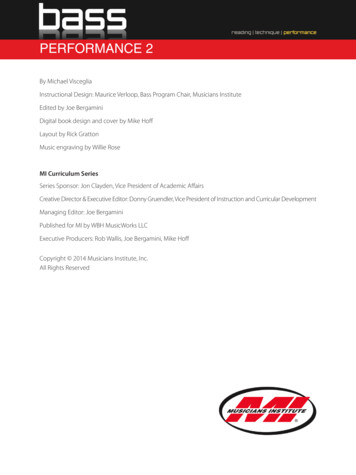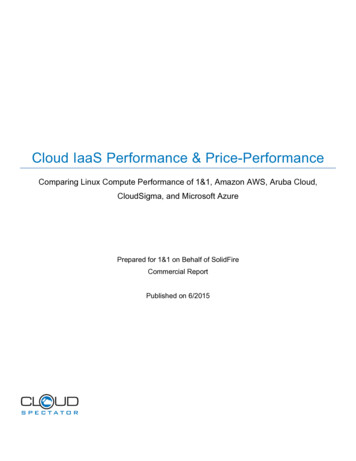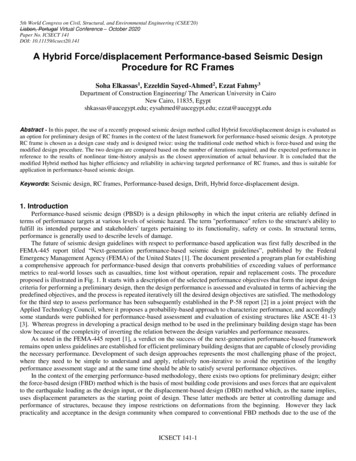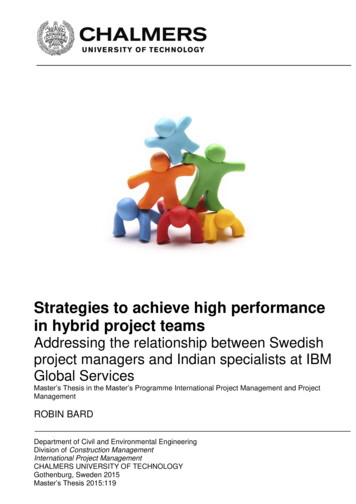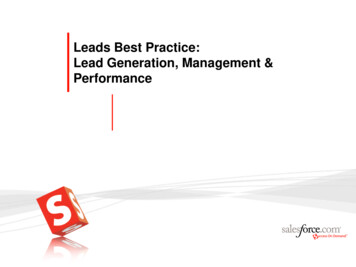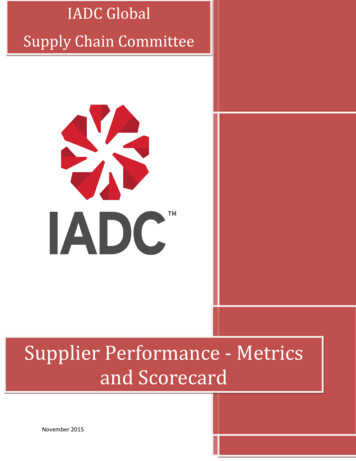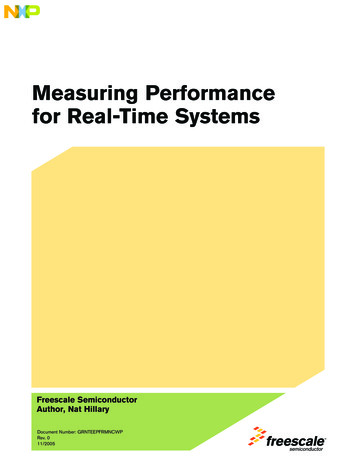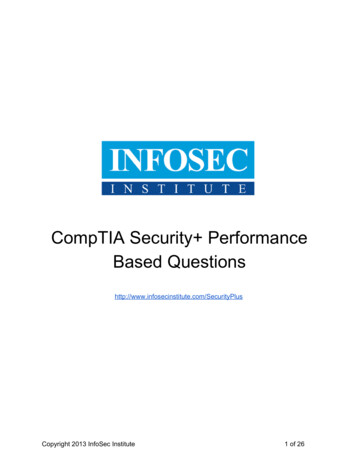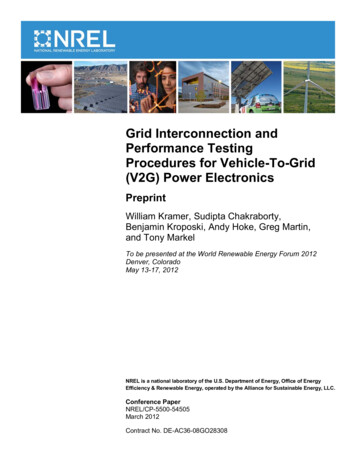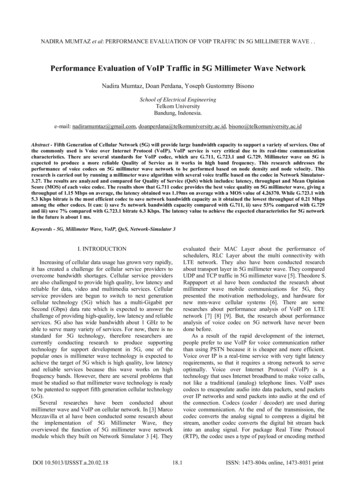
Transcription
NADIRA MUMTAZ et al: PERFORMANCE EVALUATION OF VOIP TRAFFIC IN 5G MILLIMETER WAVE . .Performance Evaluation of VoIP Traffic in 5G Millimeter Wave NetworkNadira Mumtaz, Doan Perdana, Yoseph Gustommy BisonoSchool of Electrical EngineeringTelkom UniversityBandung, Indonesia.e-mail: nadiramumtaz@gmail.com, doanperdana@telkomuniversity.ac.id, bisono@telkomuniversity.ac.idAbstract - Fifth Generation of Cellular Network (5G) will provide large bandwidth capacity to support a variety of services. One ofthe commonly used is Voice over Internet Protocol (VoIP). VoIP service is very critical due to its real-time communicationcharacteristics. There are several standards for VoIP codec, which are G.711, G.723.1 and G.729. Millimeter wave on 5G isexpected to produce a more reliable Quality of Service as it works in high band frequency. This research addresses theperformance of voice codecs on 5G millimeter wave network to be performed based on node density and node velocity. Thisresearch is carried out by running a millimeter wave algorithm with several voice traffic based on the codec in Network Simulator3.27. The results are analyzed and compared for Quality of Service (QoS) which includes: latency, throughput and Mean OpinionScore (MOS) of each voice codec. The results show that G.711 codec provides the best voice quality on 5G millimeter wave, giving athroughput of 1.15 Mbps on average, the latency obtained was 1.19ms on average with a MOS value of 4.26370. While G.723.1 with5.3 Kbps bitrate is the most efficient codec to save network bandwidth capacity as it obtained the lowest throughput of 0.21 Mbpsamong the other codecs. It can: i) save 5x network bandwidth capacity compared with G.711, ii) save 53% compared with G.729and iii) save 7% compared with G.723.1 bitrate 6.3 Kbps. The latency value to achieve the expected characteristics for 5G networkin the future is about 1 ms.Keywords - 5G, Millimeter Wave, VoIP, QoS, Network-Simulator 3I. INTRODUCTIONIncreasing of cellular data usage has grown very rapidly,it has created a challenge for cellular service providers toovercome bandwidth shortages. Cellular service providersare also challenged to provide high quality, low latency andreliable for data, video and multimedia services. Cellularservice providers are begun to switch to next generationcellular technology (5G) which has a multi-Gigabit perSecond (Gbps) data rate which is expected to answer thechallenge of providing high-quality, low latency and reliableservices. 5G also has wide bandwidth about 1 GHz to beable to serve many variety of services. For now, there is nostandard for 5G technology, therefore researchers arecurrently conducting research to produce supportingtechnology for support development in 5G, one of thepopular ones is millimeter wave technology is expected toachieve the target of 5G which is high quality, low latencyand reliable services because this wave works on highfrequency bands. However, there are several problems thatmust be studied so that millimeter wave technology is readyto be patented to support fifth generation cellular technology(5G).Several researches have been conducted aboutmillimeter wave and VoIP on cellular network. In [3] MarcoMezzavilla et al have been conducted some research aboutthe implementation of 5G Millimeter Wave, theyoverviewed the function of 5G millimeter wave networkmodule which they built on Network Simulator 3 [4]. TheyDOI 10.5013/IJSSST.a.20.02.1818.1evaluated their MAC Layer about the performance ofschedulers, RLC Layer about the multi connectivity withLTE network. They also have been conducted researchabout transport layer in 5G millimeter wave. They comparedUDP and TCP traffic in 5G millimeter wave [5]. Theodore S.Rappaport et al have been conducted the research aboutmillimeter wave mobile communications for 5G, theypresented the motivation methodology, and hardware fornew mm-wave cellular systems [6]. There are someresearches about performance analysis of VoIP on LTEnetwork [7] [8] [9]. But, the research about performanceanalysis of voice codec on 5G network have never beendone before.As a result of the rapid development of the internet,people prefer to use VoIP for voice communication ratherthan using PSTN because it is cheaper and more efficient.Voice over IP is a real-time service with very tight latencyrequirements, so that it requires a strong network to serveoptimally. Voice over Internet Protocol (VoIP) is atechnology that uses Internet broadband to make voice calls,not like a traditional (analog) telephone lines. VoIP usescodecs to encapsulate audio into data packets, send packetsover IP networks and send packets into audio at the end ofthe connection. Codecs (coder / decoder) are used duringvoice communication. At the end of the transmission, thecodec converts the analog signal to compress a digital bitstream, another codec converts the digital bit stream backinto an analog signal. For package Real Time Protocol(RTP), the codec uses a type of payload or encoding methodISSN: 1473-804x online, 1473-8031 print
NADIRA MUMTAZ et al: PERFORMANCE EVALUATION OF VOIP TRAFFIC IN 5G MILLIMETER WAVE . .in VoIP technology. Generally, codecs provide the ability tosave network bandwidth [1].ITU-T (International Telecommunication Union Telecommunication Sector) makes several standards for theimplementation of VoIP. Some commonly known standardsare G.711, G.723.1, and G.729.In VoIP services, G.711 codec applied the Pulse-CodeModulation (PCM) method for voice frequency signalswhich are sampled 8000 samples / second which is 8 binarydigits per sample. G.711 encoder has a 64 Kbps bit rate.G.729 Codec is one of the good quality codecs because itcan convert voice to 8 Kbps which is less than G.711, thiscauses the G.729 codec to have more effective and efficientbandwidth utilization. G.723.1 codecs has two types of bitrates. First is the 6.3 Kbps bit rate is better quality tooptimize for high-quality voice. The second bit rate is thesmallest bit rate of 5.3 Kbps [6].StartSimulation Design of 5G Millimeter Wave in NS3EnvironmentDesigning Simulation ScenarioSimulation with G.711Codec ScenarioSimulation with G.729Codec ScenarioSimulation with G.723Codec ScenarioNoSuccessfulScenarioII. RESEARCH METHODSYesSimulation of voice codecs performance simulated inNetwork Simulator 3 by changing the amount of data rateand payload that is contained in the application structure onmillimeter wave module. Before carrying out the simulation,the calculation of total payload voice and channelbandwidth of each codec for conventional network will becarried out, the results of calculations performed will becompared with the throughput results of simulation inNetwork Simulator 3.Collecting DataThroughputDelayJitterAnalysisTABLE I. SIMULATION PARAMETERSParameterFrequencyBandwidthNumber of EnodeBNumber of UESchedulerPGW to Remote ServerLatencyTraffic BitrateTraffic PayloadUser’s VelocityVelocityCore NetworkConclusionValue28 GHz1 GHz110, 30, 50, 100, 150Earliest Deadline FirstFinishFigure 1. Flowchart SystemThe flowchart system for this research is presented inFigure 2. Based on the system, after designing thesimulation of 5G millimeter wave in NS3 environment,designing simulation scenario based on Table 3 isimplemented. If the scenario was succeed, throughput,latency and jitter will be collected.0.1 ms64 Kbps, 8 Kbps, 6.3 Kbps160 bytes, 20 bytes, 24bytes50 Km/Hours, 100Km/Hours, 150 Km/Hours,200 Km/HoursRandom Walk 2DEPCTable I shows the simulations parameters that carried outinto the simulation based on millimeter wave modulecharacteristics. There is a change for number of UE anduser’s velocity, it for tested the capacity for each network.The traffic bitrate and traffic payload are adapted to thecharacteristics of the codecs.DOI 10.5013/IJSSST.a.20.02.1818.2Figure. 2. Simulation TopologyISSN: 1473-804x online, 1473-8031 print
NADIRA MUMTAZ et al: PERFORMANCE EVALUATION OF VOIP TRAFFIC IN 5G MILLIMETER WAVE . .Figure 2 shows the simulation topology, there is remotehost as a server. It connected with the Packet Gatewaywhich will route the traffic to an external network. PGWconnected with S-GW for transfer traffic data to theEnodeB. EnodeB as an equipment to send radiotransmission uplink and downlink to user equipment andalso it is connected with MME to control signaling session.Min distance for the simulation is 10 meters and 200 metersfor max distance.Total packet size a b c(1)Where:a L2 Header (bytes)b IP/UDP/RTP Header (bytes)c Voice Payload Size (bytes)code bit ratevoice payload size(2)(3)Equation (3) is used to calculate total bandwidth, but thisbandwidth calculation used on conventional network.The output from the simulation is QoS parameters whichare as follows:- Latency is the time needed for the package deliveryprocess, which includes coding or decoding, ‘packetization’, processing, and network latency [10].T. Received Packet - T. Packet SentPacket Received(4)‐Throughput which is defined as the speed (rate)effective for transferring the data [11].Throughput - Received packet size Delivery Time(7)(8)Where:d one way latency (ms)e packet lossH ‐ H(x) 0 , if x 0‐ H(x) 1, if x 0The results of E-model / R Factor was correlated by theMOS. The relation between R factor and MOS has beenpresented as follows [14]:MOS 1 ( 0.035 R ) ((7 10 6) R ( R 60)(100 R ))(9)Where:R R factorTABLE II. MEAN OPINION SCORE CATEGORIESMOS4.3 – 5.04.0 - 4.33.6 – 4.03.1 – 3.62.6 – 3.1User SatisfactionVery SatisfiedSatisfiedSome User SatisfiedMany User DissatisfiedNearly All User Dissatisfied1.0 – 2.6Not RecommendedTable II shows the value of MOS and its relationshipwith user satisfication level. This research is expected toreach the level either satisfied or very satisfied level.III. RESULTS AND ANALYSIS(5)Jitter is defined as the variation in the arrival time ofconsecutive packets. Jitter is calculated over an intervalof time [12]. Target jitter for this research is 1 msbased on ITU-T standardization.DOI 10.5013/IJSSST.a.20.02.18(6)Id 7 30 ln(1 15e )Equation (2) is used to calculate total packet per secondthat will be transmitted. It includes the length of header andthe length of payload. It influenced of the bitrate and theDelay R 94.2 Ie IdIe 0.024 d 0.11( d 177.3) H ( d 177.3)Equation (1) is used to calculate total packet size thatwill be transmitted. It includes the length of header and thelength of payload.PPS Based on the results of QoS parameters, the MeanOpinion Score (MOS) is calculated. The Mean OpinionScore (MOS) is used to measure the voice quality in VoIPnetwork In this research, MOS was calculated based on theresults of E-model/R Factor calculations. E-Model/R Factoris a standard by ITU-T which is defined as a transmissionquality factor caused by latency, echo, codec andcompression and packet loss for calculate the quality ofVoIP network. The equation of E-Model / R factor ispresented in (6) (7) (8) [13].18.3This section would perform the results that we have gotafter simulated voip and video traffic in 5G millimeter waveand used NS-3 as the simulation tool. The results dividedinto 4 parts which is throughput, latency, jitter and MOSresult in Voip traffic.ISSN: 1473-804x online, 1473-8031 print
NADIRA MUMTAZ et al: PERFORMANCE EVALUATION OF VOIP TRAFFIC IN 5G MILLIMETER WAVE . .A. Throughput Performance EvaluationBased on equation (1) (2) and the value of bitrate andpayload size for each codecs, the calculation of total packetsize and total packet per second for each codec presented onTable III.TABLE III. CHANNEL BANDWIDTH P PacketVoIP 2.812580000240001590016800Based on Table III, for G.711 codec can send 50 voippacket per second. Moreover, the G.711 codec has morevoip packet than the other codec. Voip packet value andvoip packet per second value affect the amount ofthroughput. Codec G.723.1 is the most efficient codec tosave network bandwidth in VoIP service. It can save 5xnetwork bandwidth capacity compared with G.711, save53% compared with G.729 and save 7% compared withG.723.1 bitrate 6.3 KbpsThroughput result from simulation gets higher than thethroughput result from calculation on Table 4. It is becausein cellular network beyond 3G, for real-time servicesespecially for VoIP, it has own path called IP MultimediaSubsystem (IMS). So VoIP traffic will not collide with theother traffic. Based on Figure 3 it can be concluded that themore number of users, the throughput will decrease due tothe bandwidth capacity which will be shared with severalusers.B. Latency Performance EvaluationTable III shows the widest bandwidth channel obtainedby G.711 codec, because the G.711 codec has the highestdata rate and payload value among the other voice codecs.Latency is used to determine the duration time to deliverthe packet. Target latency for 5G is 1 ms and target latencyof ITU-T standardization is 150 ms.Figure 4. Latency Result for G.711, G.729, and G.723.1 CodecFigure 3. Throughput Result for G.711, G.729, and G.723.1 CodecFigure 3 shows the throughput from the simulationresults. It shows that G.711 codec gets the highestthroughput among the other codecs. The G.711 codec getsan average throughput of 1.15 Mbps. The G.729 Codec getsan average throughput value of 0.32 Mbps. The G.723.1codec with a 5.3 Kbps bitrate gets an average throughput of0.21 Mbps while the G.723.1 codec with a 6.3 Kbps bitrategets an average throughput of 0.22 Mbps.The G.711 codec gets the highest throughput because ithas 64 Kbps bitrate so it can send more packet at one time.Throughput is defined as the speed (rate) effective fortransferring data, so bitrate affects the amount of packet datathat will be delivered.DOI 10.5013/IJSSST.a.20.02.1818.4Figure 4 shows the latency from the simulation results.The G.723.1 bitrate 5.3 Kbps codec obtained the highestaverage latency of 1.24 ms, G.723.1 codec with a 6.3 Kbpsbitrate obtained an average latency of 1.22 ms. G.729 codecobtained an average latency of 1.21 ms and G.711 codecobtained the lowest average latency of 1.19 ms.The latency of G.723.1 bit rate 5.3 Kbps codec gets theworst / highest latency, because it has lower bitrate than theother codecs. It only has bitrate about 5.3 Kbps.The latency for this research has achieved the latencycharacteristics that set by ITU-T G.1010 which is around 0150 ms for acceptable latency [15]. This latency alsoachieved the expected latency for 5G network which isabout 1 ms [16]. Based on Figure 4 it can be concluded thatthe more number of users, the latency will increase due tothe waiting time for each user to be served is getting longer.ISSN: 1473-804x online, 1473-8031 print
NADIRA MUMTAZ et al: PERFORMANCE EVALUATION OF VOIP TRAFFIC IN 5G MILLIMETER WAVE . .C. Jitter Performance EvaluationJitter is used to calculate the variation in the arrival timeof consecutive packets. The standard jitter based on ITU-Tis 1 ms [15].b.G.729 CODECBased on simulation results, delay for G.729 codec is1.21 ms. So the value of R factor is:c.G.723.1 (5.3 Kbps Bitrate) CODECBased on simulation results, delay for G.723.1 (5.3Kbps) codec is 1.24 ms. So the value of R factor is:Figure 5. Jitter Result for G.711, G.729, and G.723.1 CodecFigure 5 shows jitter from the simulation results. TheG.723.1 with 5.3 Kbps bitrate codec obtained the highestjitter an average jitter of 0.0237 ms. The G.723.1 with 6.3Kbps bitrate codec obtained an average jitter of 0.0244 ms.The G.729 codec obtained an average jitter of 0.0125 ms.and G.711 codec obtained the lowest latency of 0.0105 ms.Jitter is related to latency, it is the value of the totalvariance of latency, it occurs due to the difference in arrivaltime between packets at the destination. Based on ITU-TG.1010 the value of acceptable jitter for real-time services.It can be concluded that all the codec in this research havean acceptable jitter. But, G.711 codec has the best/lowestjitter as it has the highest bitrate, so it only takes a short timeto deliver all the packets.The number of users affect the jitter. Based on Figure 5 ,it can be concluded that the more number of users, the jitterwill increase due to the waiting time for each users to beserved is getting longer and the latency is getting higher too.As we know, jitter is related to latency.D. Mean Opinion ScoreMean Opinion Score (MOS) has been calculated todetermine which codec produces the best quality for VoIPand video service. Based on equation (4) and (5), the RFactor and MOS value for each services presented in TableV. Based on (7) we calculated the value of H(x) is 0,because the value of x is 0. So we can concluded the valueof Ie for each codec is 0.024d. Based on (8) packet loss foreach codec is 0, so the value if Id for each codec is 7.a.G.711 CODECBased on simulation results, delay for G.711 codec is1.19 ms. So the value of R factor is:DOI 10.5013/IJSSST.a.20.02.1818.5d.G.723.1 (6.3 Kbps Bitrate) CODECBased on simulation results, delay for G.723.1 (6.3Kbps) codec is 1.22 ms. So the value of R factor is:TABLE IV. MOS AND R-FACTOR COMPARISONG.723.1G.723.1(5.3 Kbps) (6.3 Kbps)87.1707R Factor 87.1715 87.1710 87.1703G.711MOSG.7294.26370 4.263694.263664.26368Table IV shows the MOS for each codec is around 4.2but codec G.711 has the highest value of MOS among theother codecs. It can be concluded that codec G.711 has thebest quality for VoIP services based on this MOS value.IV. CONCLUSIONSIn this research, we compared the throughput andlatency for VoIP codec G.711, G.729 and G.723.1 based onsimulation results in Network Simulator 3. Voice over IP isa real-time service with very tight latency requirements, sowe concluded that the best codec for the best voice quality isG.711 codec. Based on the results, G.711 codec has thelowest latency than any codecs in this research. But codecG.711 is not efficient for bandwidth consumption to sendingvoice packages in one shipment, because this codec uses abandwidth of 64 Kbps for sending voice packets. Therefore,G.723.1 with bitrate 5.3 Kbps is the best codec forbandwidth efficiency. It can save 5x network bandwidthISSN: 1473-804x online, 1473-8031 print
NADIRA MUMTAZ et al: PERFORMANCE EVALUATION OF VOIP TRAFFIC IN 5G MILLIMETER WAVE . .capacity compared with G.711, save 53% compared withG.729 and save 7% compared with G.723.1 bitrate 6.3Kbps. Because it is the most efficient codec, so it’s the bestcodec to use in communication which need low bandwidthcapacity, for the example is teleconference. The latencyvalue for all VoIP codecs, has been achieved the expectedcharacteristics for 5G network which is about 1 ms. Thenumber of users affect the value of throughput, latency andjitter. For the throughput, the more number of users, thethroughput will decreased. Meanwhile, the latency and jitterwill increased due to the increasing of total user. In thefuture, other researcher could add some services such asIoT, game streaming, d2d, etc and could achieve the targetlatency of 5G network and also have a standalonearchitecture which is use 5G Core, not 4G Core ]A. H. Mohammed, K. H. Bilal and M. A. Hassan, "Voice over IPover LTE Network: A Network Review," International Journal ofEngineering, Applied and Management Sciences, vol. 28, no. 01,2015.Cisco, "Voice Over IP - Per Call Bandwidth Consumption," Cisco width-consume.html. [Accessed 2 January 2019].M. Mezzavilla, M. Zhang, M. Polese, R. Ford, S. Dutta, S. Ranganand M. Zorzi, "End-to-End Simulation of 5G mmWave Networks,"IEEE Communications Survey & Tutorials, vol. 20, no. 3, 2018.M. Zhang and M. Polese, NYU Wireless, [Online]. -mmwave.DOI 10.5013/IJSSST.a.20.02.1818.6[12][13][14][15][16]
Voice over Internet Protocol (VoIP) is a . the calculation of total payload voice and channel . Equation (3) is used to calculate total bandwidth, but this bandwidth calculation used on conventional network. The output from the simulation is QoS parameters which
